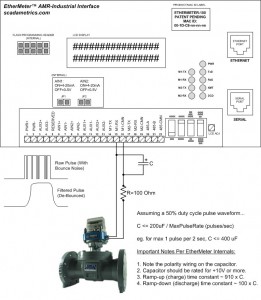Jim ‘Slim’ Mimlitz, SCADAmetrics
The capacitor value is selected based upon the expected pulse duration. If the capacitor value is too high, then true pulses can go undetected. If the capacitor value is too low, then false pulses will not be filtered away.
The purpose of this blog entry is to illustrate the correct wiring and to assist in the selection of the filter components.
Limiting Inrush Current Through The Dry Contact:
In the above schematic, a 100 ohm resistor is placed in series with the dry-contact (reed relay). The purpose of this resistor is to limit the capacitor discharge current through the dry contact. It is recommended that this resistor have a value of 100 or 50 ohms. Note that a 100 ohm resistor limits the peak current to 5V/100ohm = 50mA max, and a 50 ohm resistor limits the peak current to 5V/50ohm = 100mA max.
10 July 2015 Edit: The EtherMeter now features a “digital” debounce filter that eliminates contact bounce logically with software, rather than requiring an external hardware filter — much simpler!

